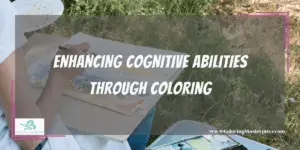Coloring is a simple and joyful pastime that encourages creativity and self-expression. Coloring tasks, on the other hand, might be difficult for those who have developmental problems or disabilities. Occupational therapy has emerged as a critical intervention in assisting people to improve their coloring abilities.
In this article, we will look at the role of occupational therapy in improving coloring skills for those who have developmental problems or disabilities.
Understanding Developmental Challenges and Disabilities

Developmental problems and disabilities comprise a wide range of conditions that have a significant influence on an individual’s physical, cognitive, and emotional development. Autism spectrum illnesses, attention deficit hyperactivity disorder (ADHD), Down syndrome, cerebral palsy, and a variety of learning difficulties all fall under this spectrum. Individuals have distinct challenges as a result of these illnesses, which emerge in numerous ways throughout their lives. Coloring tasks are a major source of frustration for many people with developmental disabilities.
Coloring may not be as simple for these people as it appears to others. Fine motor control, which is required for accurate movements of small muscles, especially in the hands and fingers, can be impaired. This, in turn, inhibits their ability to precisely hold and operate coloring instruments. Sensory integration presents additional challenges because people may fail to receive and understand sensory information while coloring. During these duties, sensory difficulties can cause discomfort, distraction, or frustration. Concentration, another important factor, may be impaired, making it difficult to maintain attention and concentrate when coloring.
To learn about the Physical Therapy Coloring Book, check out this article.
The Role of Occupational Therapy
Occupational therapy (OT) is a client-centered, holistic approach to supporting persons in overcoming obstacles that limit their capacity to engage in daily activities efficiently. When it comes to coloring proficiency, occupational therapists play a critical role in developing personalized interventions that are tailored to each individual’s particular requirements and talents.
Occupational therapists investigate the complexities of fine motor skills, sensory processing, and cognitive abilities that intertwine in this seemingly easy action, realizing that coloring is more than just a leisure pastime. Therapists curate therapies that include a variety of exercises, games, and tactics geared at improving the overall coloring experience by identifying areas of difficulty.
Individuals can improve their hand control and dexterity by receiving tailored interventions for fine motor skills, allowing them to handle coloring tools with greater precision and apply strokes more accurately. Sensory processing therapies, on the other hand, assist individuals in more efficiently processing and interpreting sensory information, resulting in a more joyful and focused coloring experience.
Occupational therapy incorporates cognitive training exercises to improve attention span, visual perception, and problem-solving abilities. Such cognitive advantages promote not only improved coloring ability but also transferable skills that can aid a variety of other elements of a person’s life.
Tailored Interventions for Fine Motor Skills
Fine motor skills are complex motions done by small muscles, primarily in the hands and fingers. In the context of coloring, these abilities are critical for grabbing and manipulating crayons or pencils as well as retaining precise control while putting strokes on paper. Occupational therapists are skilled in creating a wide range of exercises and activities that are specifically designed to improve fine motor skills, therefore enriching the coloring experience for clients.
Finger-strengthening exercises are regularly incorporated into therapists’ rehabilitation regimens. These workouts work the muscles involved in finger movements, increasing strength and endurance. Individuals’ capacity to put regulated pressure on coloring tools increases as they engage in these activities, allowing for more stable and purposeful coloring strokes.
Precision tasks, another important aspect of occupational therapy interventions, are intended to improve a person’s hand-eye coordination and finger dexterity. Individuals refine their capacity to execute intricate and exact coloring operations by participating in activities that require cautious and accurate manipulation of objects or fine motor movements.
Hand manipulation activities can help to improve fine motor abilities. These exercises consist of a sequence of actions that challenge the hands to complete sophisticated tasks like stacking objects or threading beads. Individuals who engage in such exercises regularly eventually improve their coordination and control over their hand movements, resulting in more accurate and controlled coloring.
Sensory Processing and Coloring
Sensory processing is an important element of the coloring process since it includes the ability to receive, analyze, and respond to sensory stimuli during coloring. Sensory processing difficulties might provide substantial challenges during coloring tasks for those who have developmental challenges or impairments. These difficulties may show as discomfort, distractibility, or frustration, preventing people from fully immersing themselves in the creative process.
Occupational therapists incorporate sensory integration approaches into their intervention efforts because they recognize the tremendous impact of sensory processing on coloring ability. These strategies are specifically developed to help people better receive and regulate their responses to sensory input, resulting in a more joyful and focused coloring experience.
During coloring sessions, therapists may include sensory-friendly materials to create a helpful setting for those with sensory sensitivities. These materials are carefully chosen to reduce any potential sensory overload or pain, allowing people to concentrate more effectively on the coloring activity itself.
Occupational therapists also make certain that the coloring environment is peaceful, structured, and conducive to developing a sense of ease and comfort. A clutter-free and ordered environment helps reduce distractions, allowing people to focus on their creative expression without interruptions.
Combining different sensory play activities throughout the therapy sessions enhances the coloring experience even more. These exercises engage several senses and allow people to experiment with diverse textures, forms, and sensory stimulation, building a stronger connection to the creative process.
Enhancing Cognitive Abilities through Coloring

Coloring not only provides a creative outlet but also provides a unique channel for improving cognitive abilities in people who have developmental issues or disabilities. Coloring tasks can increase attention span, concentration, visual perception, and problem-solving skills, all of which have a substantial impact on an individual’s cognitive development.
Occupational therapists acknowledge the cognitive benefits of coloring and smoothly include cognitive training exercises in their coloring sessions. These exercises have been carefully chosen to target certain cognitive domains and promote cognitive growth.
Pattern recognition exercises, for example, challenge participants to detect and recreate complex patterns while coloring. Such challenges not only sharpen their pattern recognition abilities but also stimulate brain connections, fostering cognitive flexibility and adaptability.
Sequencing exercises require organizing and coloring in a specific order, which cultivates sequential thinking and strengthens working memory. This talent is extremely useful in managing and carrying out multi-step projects in numerous aspects of daily life.
Individuals must synchronize visual perception with accurate hand motions while coloring in visual-motor integration activities. Individuals improve their hand-eye coordination and fine motor control as they master these tasks, resulting in improved overall coloring ability.
Occupational therapists establish the groundwork for the development of transferable skills by including cognitive training tasks in coloring sessions. These enhanced cognitive talents can extend beyond coloring hobbies and have a favorable impact on other elements of a person’s everyday life. Improved attention span and concentration may improve their capacity to perform academic tasks, while enhanced problem-solving skills contribute to more effective decision-making in a variety of scenarios.
The Focus on Hand-Eye Coordination
Hand-eye coordination is essential for good coloring, as it requires seamless coordination between visual information processing and accurate hand movements. Occupational therapists use a variety of intentional activities to help people improve their coloring skills, allowing them to gain higher precision and control.
Tracing activities are an important component of occupational therapy interventions aimed at improving hand-eye coordination. Individuals create a deeper connection between visual cues and motor responses by guiding their hands to follow a specified path. As a result, their ability to transfer what they observe into exact hand movements improves, resulting in more accurate and intentional coloring strokes.
Another effective approach for improving hand-eye coordination is to connect the dots. Individuals must combine scattered dots in a specified sequence in this activity, which requires careful visual tracking and coordinated hand movements. Such activities encourage the eyes and hands to function in tandem, resulting in increased dexterity and control over coloring tools.
Coloring within predefined lines is a fundamental component of hand-eye coordination exercises. Individuals who practice remaining within the lines improve their spatial awareness and hand control, resulting in cleaner and more structured artwork.
The Significance of Grip Strength
Coloring materials like crayons and pencils require adequate grip strength to be held and manipulated correctly. This is especially true for younger children. However, attaining and maintaining the appropriate grip strength can be a substantial issue for people who have developmental challenges or impairments. This makes it difficult for these people to participate easily in coloring activities.
Occupational therapists, who are highly trained in the treatment of issues related to fine motor skills, take an active role in helping these individuals improve their grip strength. They come up with a variety of grip-strengthening workouts that are adapted to the specific requirements of each individual as well as their capabilities. These exercises emphasize activating the muscles necessary for a steady and controlled grip, gradually improving both strength and endurance in the process.
They assist patients in the development of the hand and finger muscles essential for a firm grasp on coloring materials by having patients participate in exercises that specifically target grip strength. Effective resistance training can be obtained by engaging in pursuits such as squeezing stress balls, pinching clothespins, or utilizing therapy, which is a specific sort of putty. This kind of exercise leads to an increase in grip strength over time. Individuals observe a beneficial transformation in their ability to maintain a solid grasp of coloring materials as these activities are gradually included in therapy sessions. Coloring materials are one example of this capacity.
Occupational therapists may recommend adaptive equipment in addition to grip-strengthening exercises to help patients improve their grip and control of their movements. By offering ergonomic support, specialized grips that are made to fit around crayons or pencils comfortably maximize the grasping experience. It is also possible to use weighted utensils, which, because the additional weight improves proprioceptive feedback, allow users to exercise more precise control while coloring.
Individuals with developmental problems or impairments enjoy greater control over coloring tools as a result of these therapies, which ultimately leads to a rise in their level of confidence in their artistic activities. They can more effectively express their creativity and thoughts on paper since they are freed from the hassles of struggling to hold or manage the coloring materials, which allows them to do so more efficiently.
To learn how quote coloring pages elevate adult well-being, check out this article.
The information provided by ColoringMasterpiece.com (“The Site”) is for general informational purposes only. All information on the Site is provided in good faith, however, we make no representation or warranty of any kind, express or implied, regarding the accuracy, adequacy, validity, reliability, availability, or completeness of any information on the Site. Under no circumstance shall we have any liability to you for any loss or damage of any kind incurred as a result of the use of the Site or Reliance on any information provided on the Site. Your use of the Site and your reliance on any information on the Site is solely at your own risk. This blog post is for educational purposes only and does not constitute legal advice. Please consult a legal expert to address your specific needs.
Terms and Conditions: https://coloringmasterpiece.com/terms-and-conditions/

